Sun activity January 31: The sun has a visitor
Sun activity is low, with only C-class flaring. But look! The sun has a visitor. It’s comet 96P Machholz, now approaching our star. Instruments on the SOHO spacecraft captured the appearance of this cometary space tripper. And it was the late, great comet hunter Don Machholz who discovered the comet on May 12, 1986. Don was a writer for EarthSky, an honored member of our team. We miss him. Read about some of Don’s accomplishments. Meanwhile, on the sun itself, a newcomer sunspot region – now labeled AR3207 – is on the Earth-facing side of the sun and salutes with a C3.1 blast (hello, I’m here!).
Sun activity January 30: Earth photobombs the sun
A relatively quiet time continues on the sun. In the meantime, we have a fun show as Earth’s shadow gets in the way. It’s an SDO eclipse season. Twice a year, there’s a three-week period when, for about an hour each day, Earth’s shadow photobombs the sun. The geometry created by SDO’s special orbit around our planet means it will experience these brief periods in which its view of the sun gets blocked in the beautiful and dramatic way shown in the image below. Enjoy. And stay tuned as we wait for solar activity to pick up. It will!
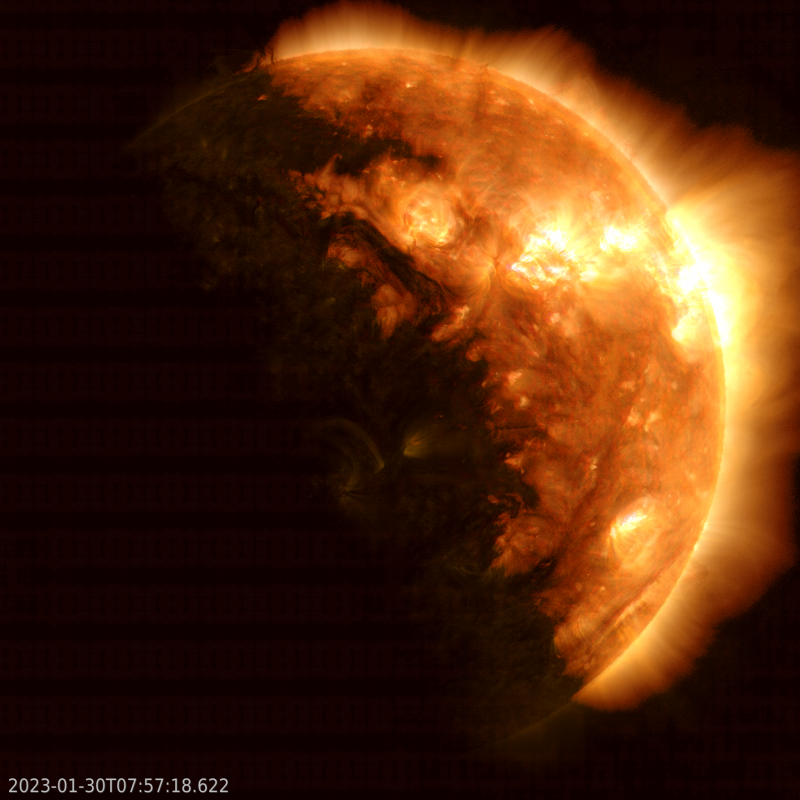
Sun activity January 29: Tick, tick, tick
Do clocks even tick anymore? If any do, you can imagine solar physicists today, standing around checking their watches and waiting on the sun to do something! But – alas – our star doesn’t operate on the timescale of solar physicists. And – despite the giant sunspot and great activity of a week ago – sun activity continues low, with the biggest flares only C flares. The most exciting action at the moment is a dynamic prominence dancing around on the sun’s northwest limb (edge). There are a few small sunspot regions and no significant coronal holes. We wait to see if something will make its way onto the Earth-facing sun. The likely candidates are what appear to be remnant sunspots AR3181 and AR3182, the regions that produced M flares and an X1 flare during their last visit. This is what helioseismology appears to be showing. Now it’s just a game of patience.
The sun in images, January 23-28, 2023
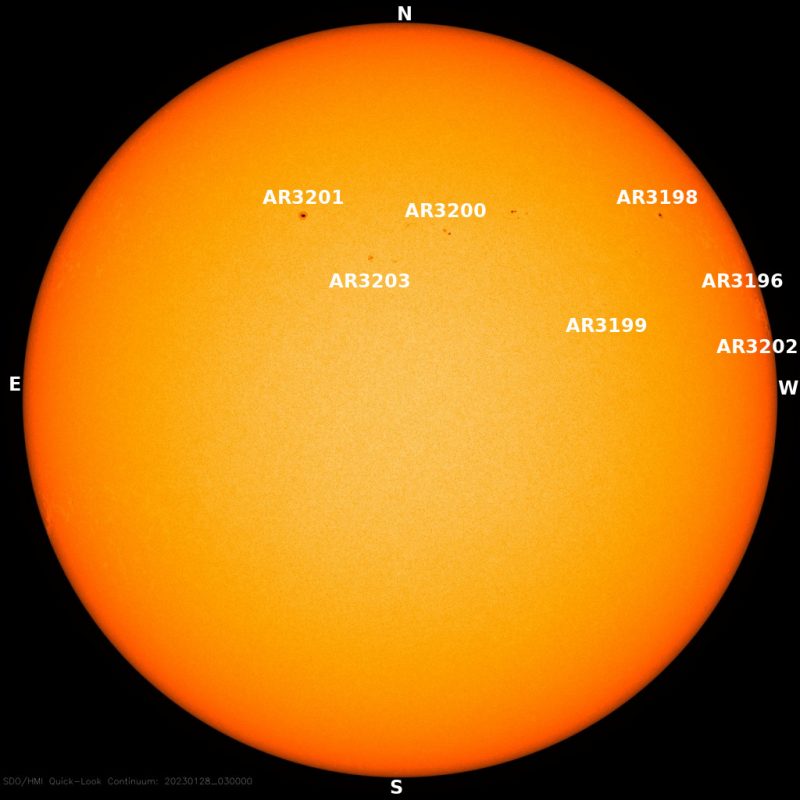

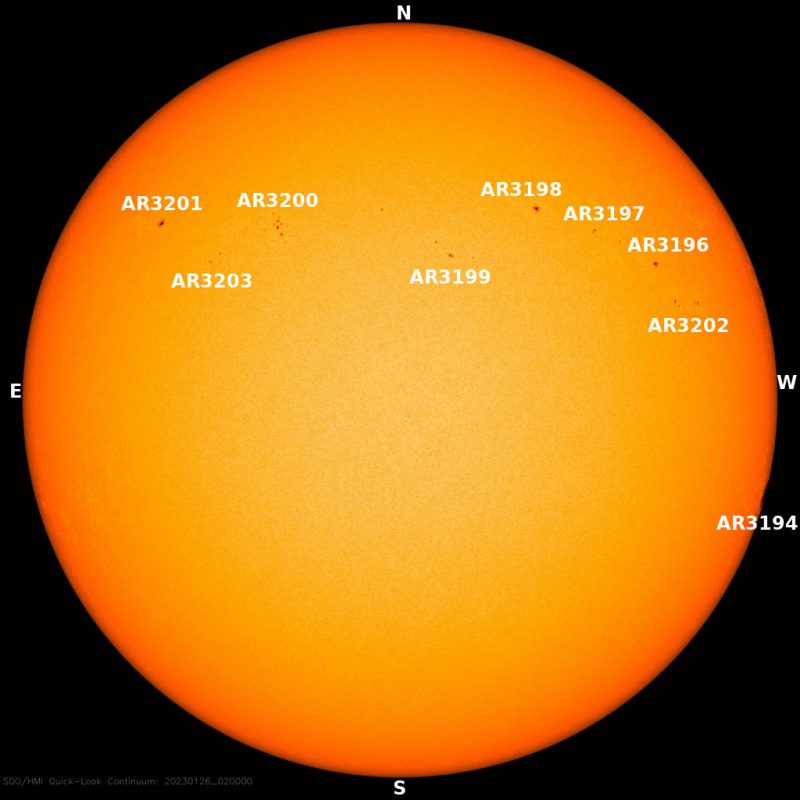
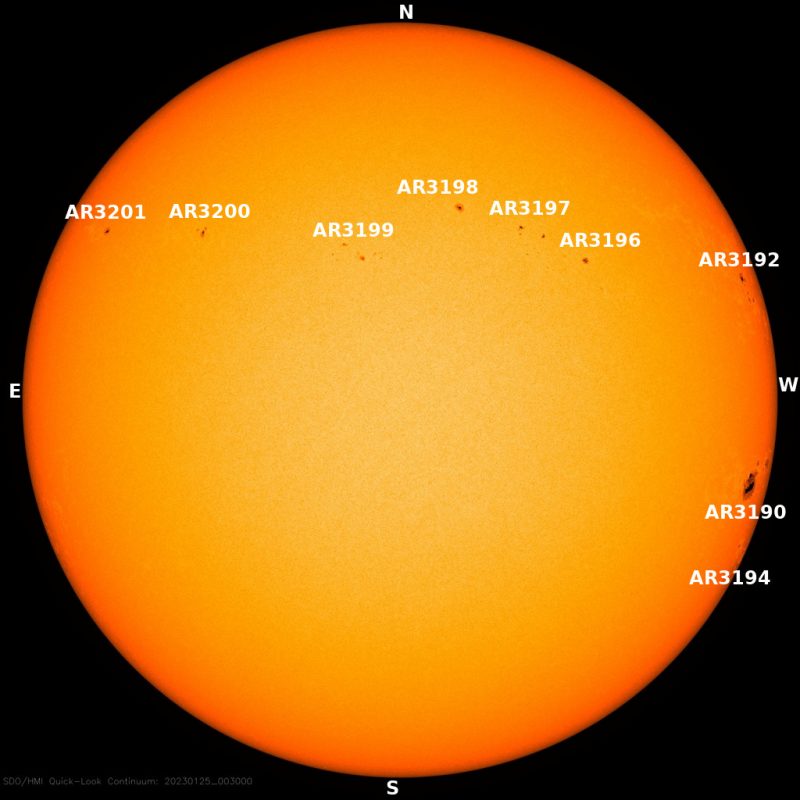
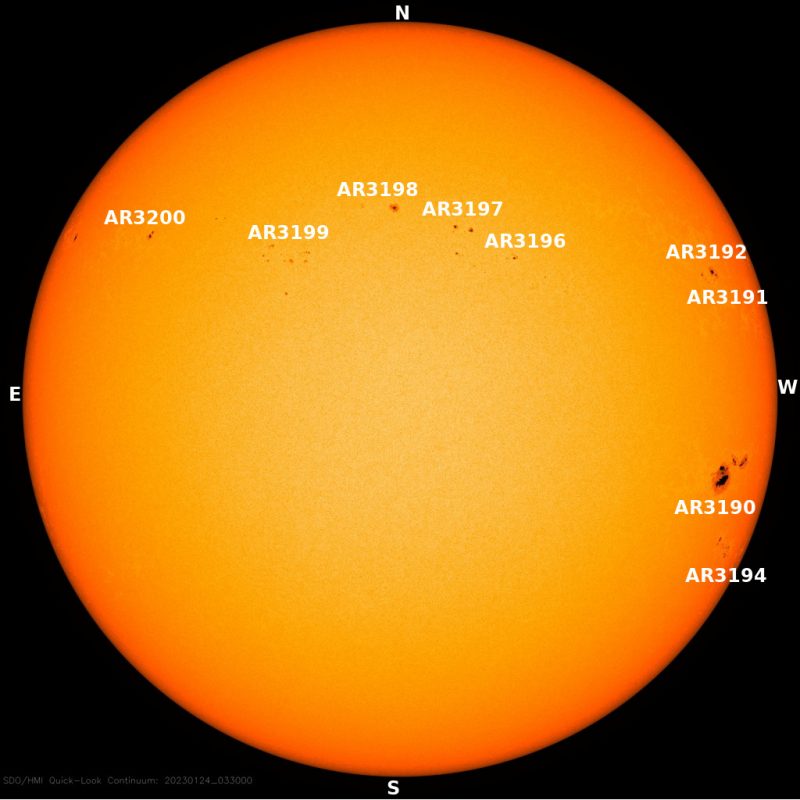
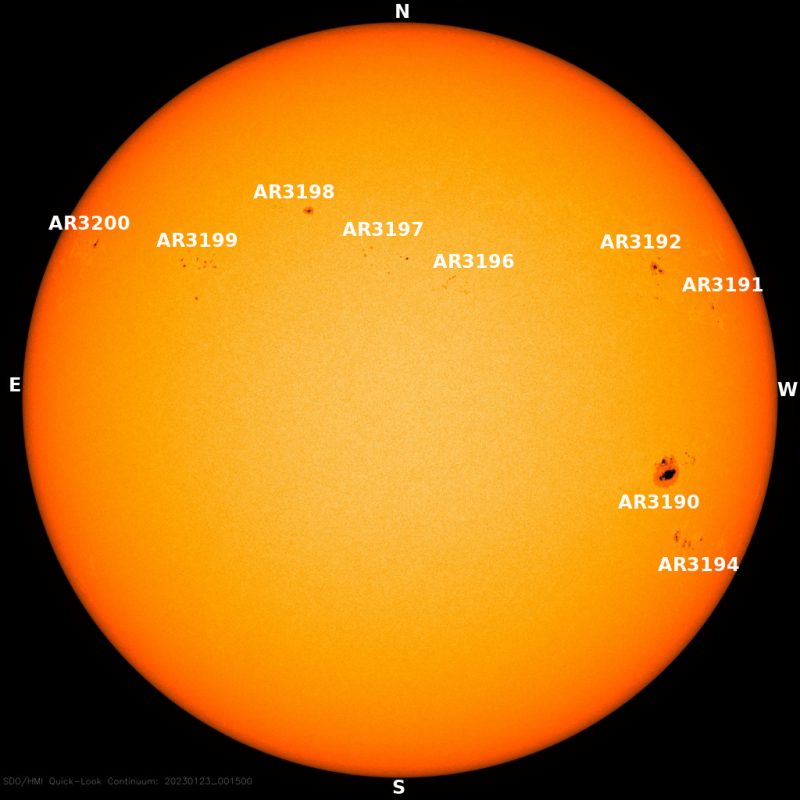
Sun activity January 22: The promise of coronal holes
Sun activity from flaring is low, but two new coronal holes promise to bring some activity here on Earth. The largest one, just west of disk center, is now in a geoeffective position. Its high-speed solar wind will soon be buffeting Earth and exciting Earth’s geomagnetic field. This means auroras at higher latitudes like Alaska, Canada, northern U.S. states, and northern Europe. This could be enhanced by the glancing blow of the filament eruption from January 20, 2023. Sunspot group AR3190 is somewhat decayed but it is still four times the area of Earth and visible from the ground with proper eye protection. It should be around for a few days more. Read about top tips for viewing the sun safely.
Sun activity January 21: Spectacular prominence eruption
Sun activity from flaring is low, but Twitter is buzzing about a spectacular prominence eruption and bright CME off the sun’s southwest limb. Wow! It’s really something. The SUVI 304 angstroms imager observed the prominence lifting off the sun around 12:30 UTC on January 20, 2023. The plasma rope and resulting bright CME moved into the SOHO/LASCO C2 field of view around 13:32 UTC January 20, 2023. The CME headed mostly away from Earth, but initial estimates are for a glancing blow. We await further analysis from forecasters. There was an eruption associated with a C5.3 flare from AR3190 around 13:47 UTC following the prominence eruption. This produced a small fast CME moving just behind the bright CME. Region AR3190 has decreased slightly in size but increased in magnetic complexity, regaining a delta spot (description of sunspot classification). It is still visible from the ground with proper protection and it should be around for a few days more. Try our top tips for viewing the sun safely.
Sun activity January 20: Big sunspot shows decay, still enormous
Sun activity continues at moderate levels, but that huge sunspot region – AR3190 – is still there! It’s worth trying to see, if you have some old eclipse glasses lying around, or solar binoculars. It has decayed somewhat over the past day, but is still huge! Just be sure to protect your eyes. This sunspot region shows a beta-gamma magnetic configuration and has exploded only C flares so far. It’s now entering the sun’s southwest solar quadrant, moving inevitably toward the sun’s far side, but it’ll be around for a few days more. Try our top tips for viewing the sun safely.
Sun activity January 19: That’s a big sunspot!
Sun activity is moderate, with two M flares in the past day. But check this out! There’s a giant spot on the sun now that you might be able to see with the eye alone, if and only if you use proper eye protection (such as eclipse glasses). Or try solar binoculars. Just be sure to protect your eyes. AR3190 is huge! It has an area of five Earths. And, since it’s in the eastern hemisphere of the sun, it’ll be around a few days. Try our top tips for viewing the sun safely.
Sun activity January 18: Early bird CME may spark auroras tonight
A flanking component of a CME that was expected to reach Earth on January 19, 2023, instead arrived early today (January 18). And NOAA specialists are forecasting possible auroras for tonight in northern states of the U.S., perhaps as far south as Minnesota and Montana. Earth’s magnetic field has been unsettled for most of the day so far, with the Kp index (aka the planetary K index) – an excellent indicator of disturbances in the geomagnetic field – reaching just below storm levels at K4. Quiet at this writing (around 11 UTC), it is expected to return to unsettled to active levels during the rest of the day today, and into January 19. At the time of this writing, NOSWE reports a disturbed geomagnetic field over Dombås in Norway. Aurora-chasers, get ready! You can submit your aurora photos to our community.
Sun activity January 17: Prominences, and a chance for flares
After a glorious week last week at high flaring levels, the sun has returned to relative calm and quiet. Sun activity is now low, in both flaring level and the number of flares produced. Our star is still producing outstanding prominences, though, like the one shown in the image below. And, on the Earth-facing side of our star, sunspot region AR3190 – the largest and most magnetically complex active region today, more than five Earths wide – shows a beta-gamma-delta magnetic configuration. It’s complex, in other words, with potential for flaring. Likewise, sunspot regions AR3186 and AR3192 present beta-gamma magnetic configuration. They’re complex and likely to flare, too, but not as complex as AR3190. Still, the complexity of these sunspots indicates a high potential for more M flares and possibly X-flares (the strongest level).

Sun activity January 16: Flares and auroras!
Sun activity is moderate with one M4.9 flare at 14:16 UTC on January 15, 2023. G1 (minor) geomagnetic storm levels were reached January 15, 2023, at 23:06 UTC and remained active the rest of the day. This activity produced auroral displays from North American to Europe at higher latitudes such as Alaska and Scotland (see tweets below). The CME observed with the M4.6 flare on January 14, 2023, is now expected to provide a glancing blow to Earth on late January 18 into January 19, 2023 (see tweet below). Three of the nine sunspot groups show delta magnetic configurations indicating high chances for more M flares with a possibility for X flares. Stay tuned for more flaring and some possible aurora on January 18-19, 2023!
Sun activity January 15: Excitement builds!
Sun activity is moderate with three M flares, including an eruptive event with an Earth-directed CME. The Earth-directed CME is expected to reach us on January 17, 2023. Here are the three M flares. Notice their ascending order of strength!
M3.5 at 20:06 UTC on January 14 (AR3182)
M4.6 at 20:37 UTC on January 14 (AR3182)
M6 at around 3:08 UTC on January 15 (AR3191)
All three M flares produced radio blackouts over the sun-facing side of Earth. We also saw a G1 (minor) geomagnetic storm due to a glancing blow from a January 11, 2023, CME. Three sunspot regions have strong potential for continued flaring, AR3182, AR3186, and AR3191. AR3182 and AR3191 produced the M flares. The next few days could get exciting, perhaps even more exciting than the past week of X flares. It could be a week of flares and auroras. Stay tuned!
Sun activity January 14: It was a big week for the sun
Sun activity has now dropped to moderate. But that’s after an active week for the sun, surely the most active we’ve seen this year, and perhaps the most active since Solar Cycle 25 began officially in December 2019. The cycle is expected to peak around 2025. And this week we had three X flares – the strongest category of solar flare – plus multiple M flares (2nd-strongest) so far. Over the past day, the sun produced one M flare. Newcomer active region AR3191, in the northeast quadrant, blasted it out earlier today (2:10 UTC on January 14, 2023). The M flare produced an R1 (minor) radio blackout that affected Australia’s east coast. Elsewhere on the sun, watchers saw a sigmoid (S-shaped) structure following a C8.5 flare, blasted out by an unidentified region close to AR3184, beginning at around 15 UTC on January 13 (see image above). And remember how we said yesterday that the whole east limb (edge) looked fiery? Today, we see why: a newcomer coming into view on the southeast (now labeled AR3190) plus two newcomers in the northeast (AR3191 and AR3192). Now there are a whopping 10 labeled active regions on the Earth-facing side of the sun. That’s the biggest number of labeled active regions seen at once so far in 2023.
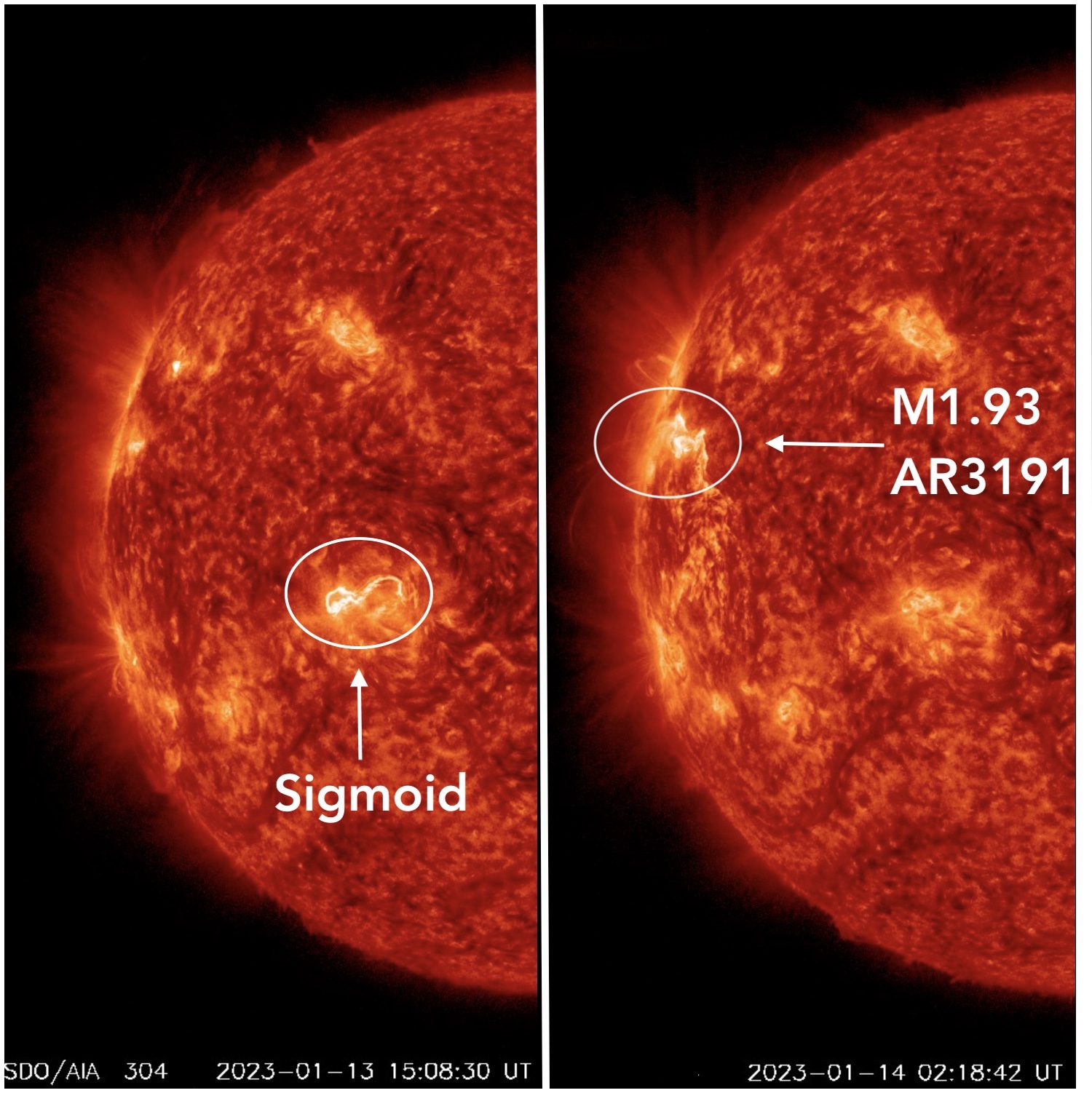
Sun activity January 13: Another 5 M flares
Sun activity has returned to high, with five M flares over the past day (11 UTC on January 12 to 11 UTC on January 13). Here’s the breakdown:
M1.2 at 11:28 UTC on January 12 (AR3181)
M1.0 at 14:57 UTC on January 12 (AR3182)
M1.1 at 19:13 UTC on January 12 (AR3182)
M1.4 at 02:59 UTC on January 13 (AR3186)
M4.0 at 10:15 UTC on January 13 (AR3181)
Note that AR3181 and AR3182 both blasted out two M class flares each. And each of these flares produced its corresponding R1 (minor) radio blackout over Earth’s Southern Hemisphere, where – if you’ll recall – it’s now summer (hence sunlight is striking more directly now in the Southern Hemisphere). The most recent radio blackout affected South Africa at 10:17 UTC on January 13. No Earthbound CME detected. Back at the sun … a fiery active east limb (edge) is observed. We’re seeing long-lasting prominences all over the east horizon of our star (see the image below), the side of the sun that’s just now rotating into view. Some of these prominences seem to come from the close-to-the-edge far side. All this is coincident with the appearance of a newcomer on the southeast, not numbered yet until it can be completely seen. But, from here so far, it seems to be a large active region with a complex geomagnetic configuration with enough credentials to be a strong flare producer. Will it be our next main player? We’ll see.
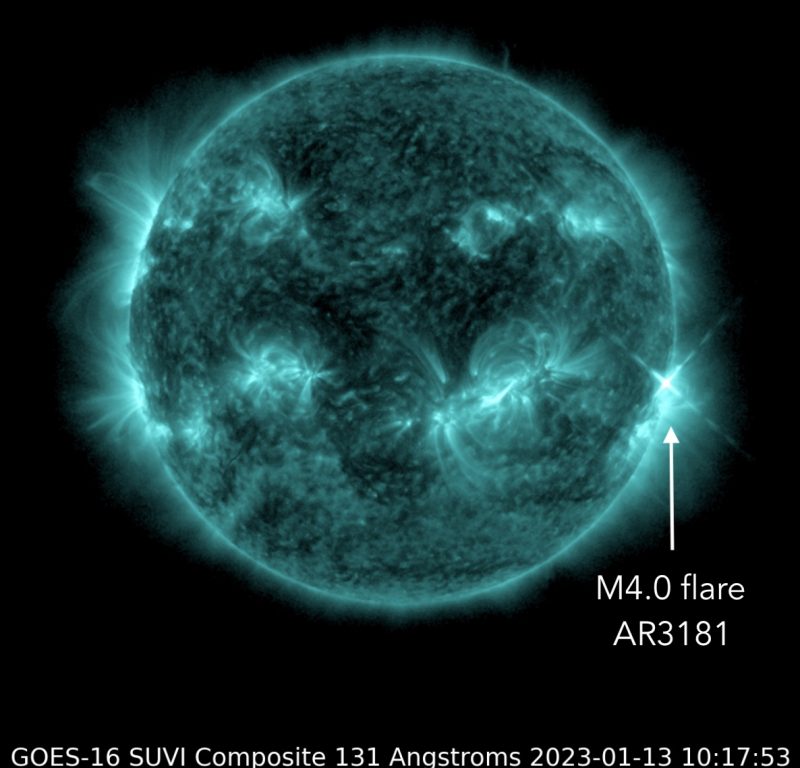
Sun activity January 12: Two M flares in sequence from AR3186
After three days of intense activity in both X and M flaring, sun activity is back to low. Still, early this morning (January 12, 2023), the sun blasted two M flares in sequence from a single active region, in the sun’s northeast quadrant:
M1.1 at 6:18 UTC on January 12 (AR3186)
M1.6 at 6:50 UTC on January 12 (AR3186)
Not so long ago, two M flares in sequence would have been big news! But after the excitement earlier this week … ho hum. Still, these flares did what flares do. They caused R1 (minor) radio blackouts, this time affecting the South Indian Ocean. CMEs were detected, but none is Earth-oriented.
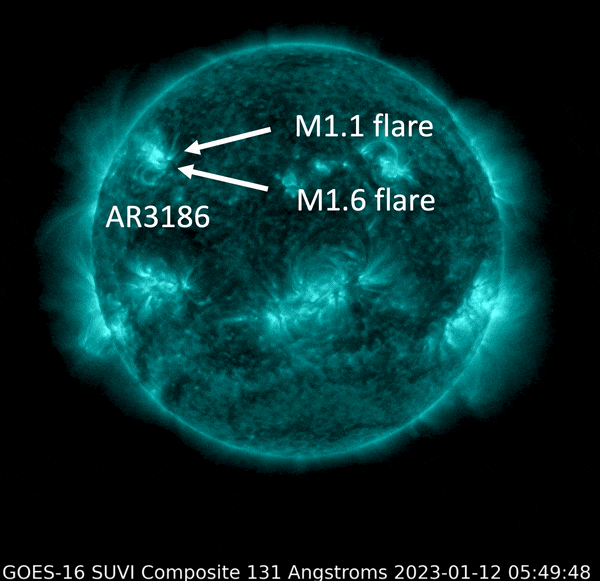
Sun activity January 11: Another X flare … and 7 M flares
Sun activity is extremely high this week, in contrast to anything we saw throughout 2022. After all, Solar Cycle 25 is heading toward its peak, due around 2025. As of this writing, in the past 24 hours, we’ve seen seven M flares, plus another X flare. The X flare was accompanied by a tremendous beautiful prominence (shown in our top animation). The sun now has three sunspot regions that carry the potential for significant flaring in the M and X range, AR3181, AR3182, and AR3186. Lots of sun fun! Stay tuned! Here’s the breakdown of the M and X flaring production during the past day:
M1.0 at 11:08 UTC on January 10, 2023 (AR3185)
M1.3 at 17:28 UTC on January 10 (AR3186)
M1.2 at 17:48 UTC on January 10 (AR3184)
X1.0 at 22:47 UTC on January 10 (AR3186)
M2.4 at 00:59 UTC on January 11 (AR3186)
M5.6 at 01:56 UTC on January 11 (AR3184)
M1.3 at 06:09 UTC on January 11 (AR3181)
M3.1 at 08:33 UTC on January 11 (AR3186)
Yesterday’s hero AR3184 yielded its place to newcomer AR3186, which this time takes the lead in flare production, with three out of the seven M flares of the day. Plus, AR3186 produced the X flare. A few minutes after the X flare, we saw a R3 radio blackout over Polynesia on the South Pacific Ocean. And the most recent M flaring from AR3186 produced a R1 (minor) radio blackout at 8:34 UTC over Madagascar and the South Africa east coast. Once again, no Earth-directed CMEs were produced during these events and no coronal holes are in sight, for now.
Sun activity January 10: X flare … and 4 M flares
Sun activity is high! As of this writing (11 UTC on January 10, 2023), we’ve had four more M flares in the past day, plus an X flare late in the day yesterday. And there’s a 35% chance of X flares today!
M1.0. at 13:22 UTC on January 9 (AR3181)
X1.9 at 18:50 UTC on January 9 (AR3184)
M5.1 at 0:16 UTC on January 10 (unnumbered region, northeast limb)
M1.0 at 2:16 UTC on January 10 (AR3184)
M2.7 at 2:41 UTC on January 10 (AR3181)
The very eloquent sunspot region AR3184 has been outstanding, as expected even before it came fully into view on the sun’s southeast limb. The X flare created an R3 radio blackout over the Pacific Ocean (see tweet below). And its close competitor in M flaring – AR3181 – also had two M flares over the past day. This was the second day in a row that the sun produced four M flares, with the added bonus of yesterday’s X flare. By the way, no Earth-directed CMEs were produced during these events and no coronal holes are in sight for now.
Sun activity January 9: Flares on Flares
Sun activity is high. The largest flare was the X1.9 by AR3184 at 18:50 UTC on January 9, 2023. We saw a total of 23 flares in the past day, one X flare, four M flares and 18 C flares. The main player was AR3184 with nine flares produced, the X flare included. The sun bears six labeled active regions today. There is an active region on the northeast limb that’s already produced M flaring, but that hasn’t been labeled yet.
Sun activity January 8: A new region is coming
Sun activity has reached moderate levels. AR3182 now harbors even more potential to produce an X-flare and there is a new sunspot contender coming into view. AR3182’s magnetic complexity has increased to include a delta configuration, indicating that opposite types of the magnetic field in a sunspot (positive and negative) are mixed together and so more prone to erupt. And – just now coming into view – we now have a region not yet numbered that produced two M flares – an M1.2 and M1.4 – within 45 minutes of one another. The flares are most likely larger, because the body of the sun is partly blocking them from our view. This new spot adds to the excitement of the past few days, increasing the overall chances for significant flaring. Both M-class events caused minor radio blackouts over Africa. Stay tuned! It could get interesting.
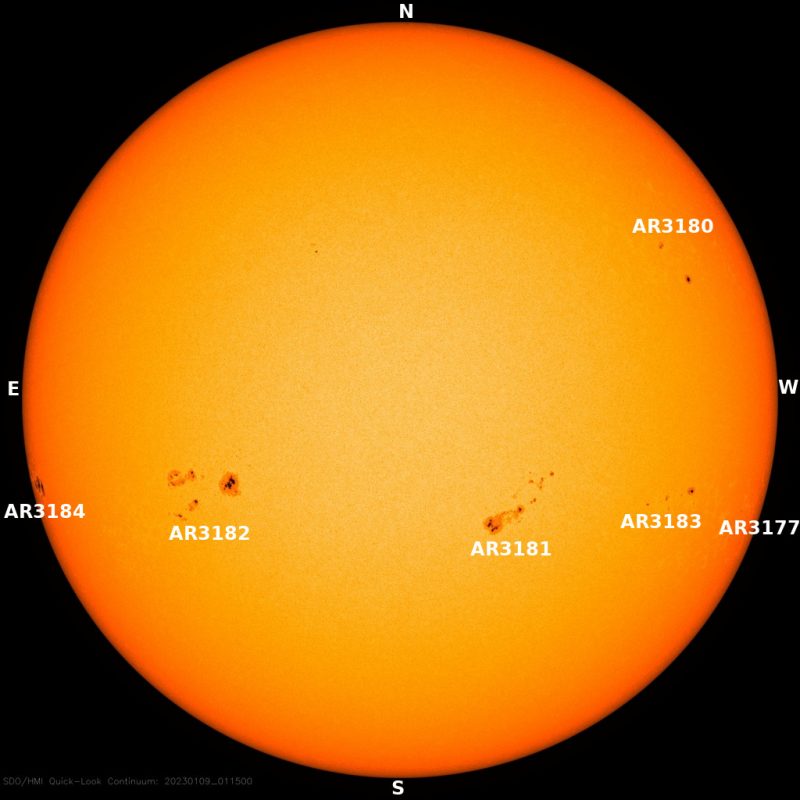
Sun activity January 7: 20% chance of X flares today
Almost exactly 24 hours after yesterday’s X flare, sunspot region AR3182 blasted out an M1.6 flare earlier today. This active region has just been carried into view by the sun’s rotation, on the sun’s southeast limb (edge). It had blasted a huge flare while still on the far side of the sun on January 3. Then we saw yesterday’s X flare, and now this M flare. That’s one reason NOAA specialists increased the chances for X flaring to 20% today. Today’s M flare occurred at 00:40 UTC on January 7, 2023. Same as yesterday, the corresponding radio blackout, an R1 (minor) one, affected New Guinea and Polynesia in the South Pacific Ocean. Elsewhere on the solar disk, the S-shaped sigmoid structure we saw on January 5 (more about it below) remained and C2.6 flaring came out of this region. It happened at 16:45 UTC on January 6, and the active region involved is again AR3177. Also, a fiery active prominence can be seen on the southwest solar horizon. See the animation below. Interesting events are happening on our star and surely more to come! Stay with us.
Sun activity January 6: X flare!
Sun activity is high! Sunspot region AR3182 blasted out an X flare – the strongest category of flare – earlier today. Before today, the most recent X flare happened on October 2, 2022. Today’s flare measured X1.2. It started at 00:43 UTC on January 6, 2022. Experts are calling this X flare a non-eruptive flare. That means no CME was observed. There are two great things about today’s X flare. First, it’s from a region on the sun that’s just now rotating into view. Second, it’s now showing a gamma configuration, a complex and potentially active configuration, so we can expect this region to continue to produce strong flaring. In fact, we began seeing it flare a few days ago, on January 3, 2023, when it was still on the far side of our star. Since its appearance, yesterday and so far today, this active region has shown multiple C-class flares, too, with six C flares plus this X flare in the past day. As a result of the blast, an R3 (strong) radio blackout affected New Guinea and Polynesia in the South Pacific Ocean.
Sun activity January 5: A sigmoid – or S-shaped – flare
Sun activity is low. But an erupting sigmoid in sunspot region AR3177 provided some sun fun late yesterday. These S-shaped regions are often the source of large eruptions, as they tend to harbor built-up explosive energy. This one produced a C8.4 flare, not a super-large flare, but the sigmoid shape – a twisted filament – became clear as the flare erupted (see animation). Elsewhere on the sun, we said farewell to sunspot region AR3179 as it rotated over the west limb (edge). And – in what might be the return of an old friend, AR3163 – a new sunspot has rotated into view and been labeled as AR3182. This region produced the huge backside eruption reported yesterday. Back at Earth, the G1 (minor) geomagnetic storm is over. But more geomagnetic activity might come. The storm left many beautiful images of auroral displays before it ended. See the tweets below.
Sun activity January 4: The geomagnetic storm is here
At the time of this writing (11 UTC on January 4), the G1 (minor) storm is raging in Earth’s magnetic field. The storm threshold was reached at 5:21 UTC on January 4, after a disturbance was measured ahead of Earth at 2:54 UTC. The disturbance was due either to a CME arrival, or to fast solar wind, or both. There’s a gap in the solar wind data during this time, making it hard to say for sure. The storm is predicted to continue through about 15 UTC today. This is all primarily during nighttime in North America and that means auroral displays are probably ongoing at northern latitudes. This could include U.S. states such as Minnesota and Michigan. NOSWE in Norway reports a disturbed geomagnetic field in Tromsø and Ny-Ålesund. Clear skies to you, aurora-chasers! And happy perihelion, our closest point to the sun for all of 2023, today!
Sun activity January 3: Auroras due overnight tonight
Sun activity is low today. But excitement on Earth is high, as a G1 (minor) geomagnetic storm is predicted during the day today and early tomorrow. The storming is expected to peak at 9 UTC on January 4, 2023, extending through 15 UTC. That’s early Wednesday, according to clocks in North America. G1 (minor) storming might provoke auroral displays at northern latitudes, as far south as the northern U.S. states (for example, Maine and Montana). Clear skies to you, aurora-chasers!
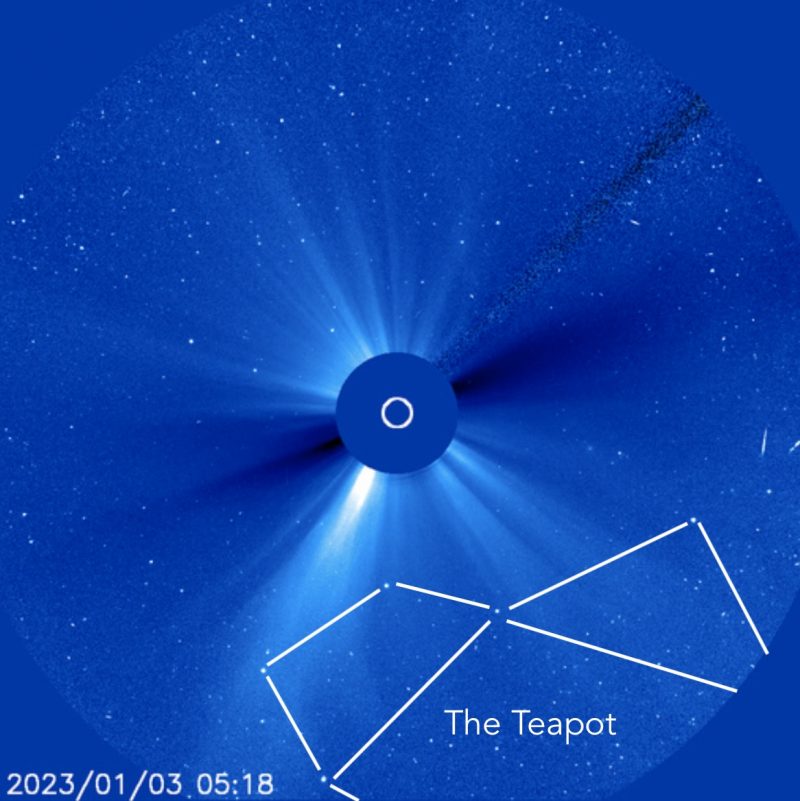
Sun activity January 2: Solar wind and CME heading our way
Happy 2023, everyone! The new year has started with low sun activity, that is, with only minor flaring. But we’re due for some sun fun here on Earth, anyway, possibly as soon as tomorrow evening in the Americas (early on January 4 in Europe). Notably, a glancing blow from a December 30 CME – and high-speed solar wind from a coronal hole – should reach Earth then (early to midday January 4, as measured in UTC). Furthermore, a combination of these two could excite Earth’s magnetic field to G1 (minor) storming levels and spark enhanced auroras at higher latitudes (Alaska, Canada, the northernmost U.S. states, and northern Europe). Clear skies and good luck to you, aurora-watchers! Submit your recent photos of sunspots and auroras. View EarthSky Community Photos here.
Bottom line: Sun activity archive for January 2023. A daily record of flaring, and other sorts of activity, on our local star.











